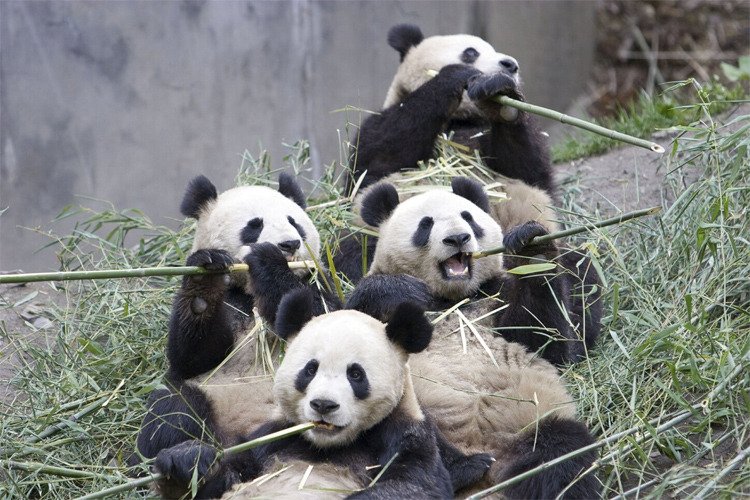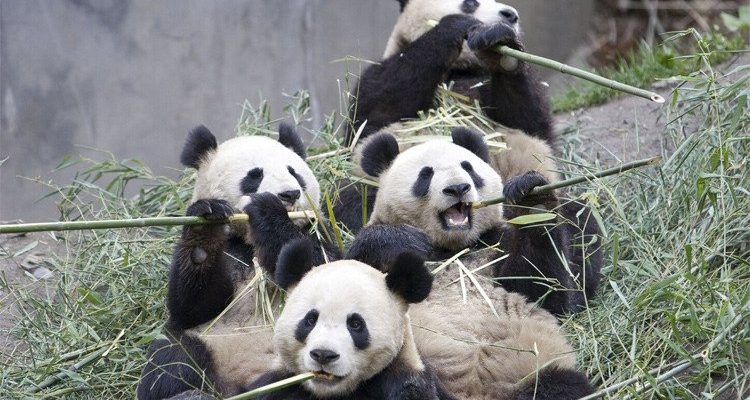
Let’s get one thing straight: giant pandas are not fierce hunters. Instead, they’ve evolved into specialized bamboo eaters. Their diet is surprisingly limited, focusing almost entirely on one type of food. You might be wondering how something like a panda survives on such a narrow menu. Well, let me explain how this lifestyle shapes their behavior and survival in the wild.
What Do Giant Pandas Eat?
Giant pandas primarily feast on bamboo, which makes up about 99% of their diet. It’s like having a favorite dish that you just can’t get enough of! The other 1% of their diet might include small animals or carrion, but that’s rare. Pandas have adapted to eat many different species of bamboo, which grow abundantly in their natural habitat. Their strong jaws and large molars help them crush and grind bamboo effectively, making the tough stalks easier to digest.
Here’s the thing: bamboo is not particularly high in nutrients. This means pandas have to consume large quantities—up to 28 pounds per day—to meet their energy needs. Imagine having to snack on the same thing all day long! To compensate for this, pandas spend up to 16 hours a day eating. Sounds like a full-time job, right?
Interestingly, pandas have a slow metabolic rate to conserve energy since their food is low in calories. This slow rate can be compared to how sloths take their time moving around. You might be surprised to learn that despite their hefty size—adult pandas typically weigh around 220 to 330 pounds—they’re not the most active animals. Most of their day is spent munching away or lounging in a tree.
How Do Pandas Hunt? Or Do They?
You might think that hunting is all about speed and stealth, but for pandas, it’s quite different. In reality, they don’t hunt like traditional carnivores. Instead, they forage for that precious bamboo. Their hunting strategy, if we can call it that, revolves around locating bamboo stands that are in good condition, which is more about finding than hunting.
Pandas use their keen sense of smell to help them locate fresh bamboo. They can sniff out potential food sources from a distance, which is incredibly handy in the dense forests where they live. Once they find a suitable patch, they’ll delicately make their way to it, using their powerful forelimbs to pull bamboo stalks down. This is where those strong jaws come into play, allowing them to chew through tough fibers.
While they aren’t hunters in the traditional sense, giant pandas can be quite curious and social, sometimes climbing trees to explore or keep an eye out for other animals. If you see a panda in a tree, they’re likely just enjoying a snack or looking out for their next meal. It’s a laid-back lifestyle, and it works for them!
The Role of Habitat in Panda Diet
The habitat of giant pandas plays a crucial role in their diet. They thrive in mountainous regions with cool, damp climates, which are perfect for bamboo growth. These areas are usually covered in dense forests, providing not just food but also shelter. Without a suitable environment, their specialized diet would be hard to maintain.
Bamboo doesn’t flower every year, and when it does, it can die off completely afterward. This phenomenon can be challenging for pandas. When a bamboo species dies, they must migrate to find another food source, which can lead to competition with other pandas. It’s a bit like when your favorite restaurant runs out of your go-to dish—you have to search for a new spot to satisfy your cravings.
Due to habitat loss from human activities, pandas are now mostly found in nature reserves and national parks. These protected areas ensure a stable food supply and minimize human-panda interactions. Conservation efforts are essential to maintain their habitat and, in turn, their specialized diet.
Adaptations for Eating Bamboo
Eating bamboo isn’t as simple as it sounds. To thrive on a bamboo diet, giant pandas have developed several unique adaptations. One of the most notable features is their pseudothumb, which is an elongated wrist bone that helps them grip bamboo stalks effectively. It’s like having an extra finger just for eating!
Another important adaptation is their gut. Pandas have a digestive system that’s more similar to a carnivore’s, but they have evolved to extract as many nutrients as possible from bamboo. They have a short gastrointestinal tract that allows them to process their food quickly, but this also means they need to consume a lot.
Additionally, pandas possess a keen sense of taste specifically tailored for bamboo. They can detect which species are the freshest and most nutritious, ensuring they get the best possible meal. Imagine being able to pick the ripest fruit or the freshest greens at a market! That’s the level of skill these bears have developed.
Challenges to Their Diet and Hunting Strategies
The giant panda’s diet and hunting strategies face several challenges, not only from their specialized eating habits but also due to environmental factors. In recent years, climate change has affected the availability of bamboo, leading to food shortages. Just like us, pandas rely on a stable food supply, and when it dwindles, so do their chances of survival.
Another issue is habitat loss from deforestation. As urban areas expand, the spaces pandas need to thrive are shrinking. This creates barriers that make it harder for them to find food and mate. Their unique diet becomes a double-edged sword—its specialization helps, but it also makes them vulnerable to changes in their environment.
Additionally, human interference can sometimes lead to negative interactions. If a panda wanders into a populated area in search of food, it can lead to dangerous encounters. It’s a tough world out there for these gentle giants, and conservation efforts are increasingly crucial to ensure they can continue their bamboo-centric lifestyle.
Conservation Efforts and Their Impact on Panda Diet
Thanks to conservation efforts, giant pandas have made significant strides toward recovery. Various initiatives focus on protecting their habitat and ensuring a stable bamboo supply. By setting up reserves and national parks, we’re not only helping pandas find food, but we’re also safeguarding their way of life.
Moreover, zoos and wildlife organizations are involved in breeding programs. These programs help increase the population and ensure genetic diversity, which can lead to healthier bears. Some of these facilities even grow special bamboo gardens to provide a consistent food source for pandas in their care.
Awareness campaigns also play a vital role. They educate people about the importance of preserving natural habitats and the role pandas play in their ecosystem. When people understand that protecting pandas means protecting forests and biodiversity, they’re more likely to take action. It’s a win-win situation for both the pandas and the planet!
Giant pandas are a captivating blend of unique eating habits and gentle behaviors. Their diet, primarily composed of bamboo, defines their lifestyle and influences their habitat choices and survival strategies. Although they may not hunt in the traditional sense, their foraging techniques and adaptations make them perfectly suited for their specific needs.
With ongoing conservation efforts, there’s hope for these amazing creatures. By understanding their diet and the challenges they face, we can act to protect their future. So, the next time you picture a panda munching away, remember that there’s a whole world of complexity behind that adorable face! We must continue to support these gentle giants and ensure they can thrive in their bamboo-filled homes for generations to come.

